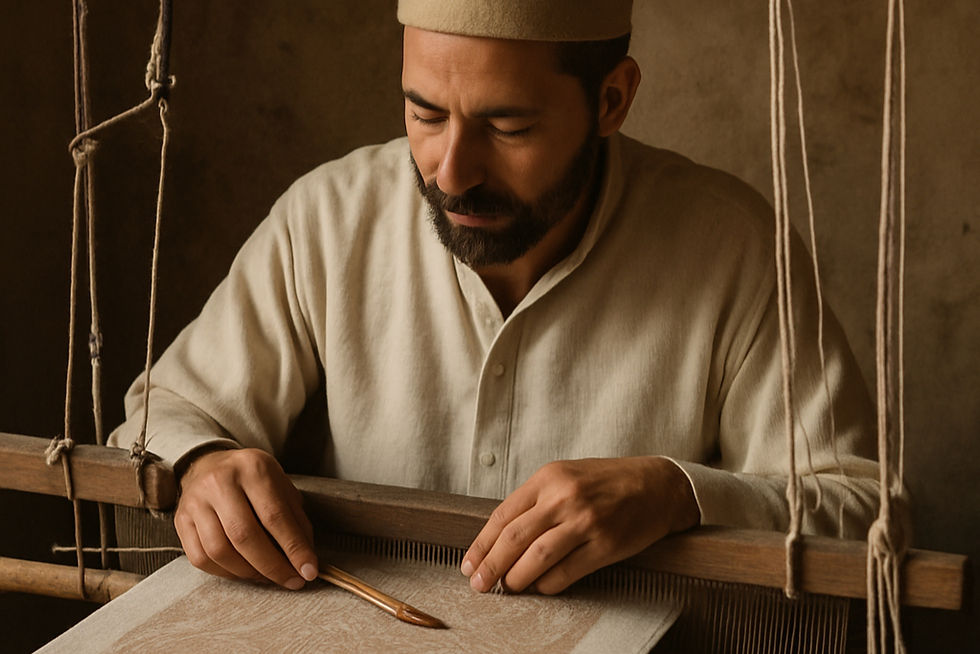Understanding Cashmere vs. Pashmina: Key Differences
- Paul Tyler

- Jul 18
- 1 min read

When shopping for luxurious wool products, you may come across two terms that often cause confusion: cashmere and pashmina. Both are known for their softness and warmth, but they are not exactly the same. This article will guide you through the primary differences between cashmere and pashmina, helping you make informed decisions during your next purchase.

Cashmere is a type of wool that comes from the soft undercoat of cashmere goats. These goats are primarily found in the Himalayan regions of China, Mongolia, and Nepal. The wool is known for its softness, lightweight, and excellent insulation properties, making it a popular choice for high-end apparel.
How is Cashmere Made?
The production of cashmere begins with the goats naturally shedding their winter coats. Farmers collect the soft undercoat either by hand combing or shearing. The wool is then cleaned, sorted, and spun into yarn. The entire process is labor-intensive, contributing to the high cost of cashmere products.
What is Pashmina?

Pashmina, often referred to as the "soft gold" of fibers, is a finer type of cashmere wool. It comes from the underbelly and throat of the Changthangi goats, a special breed found in the Ladakh region of India. The term "pashmina" is derived from the Persian word "pashm," meaning "soft gold."
How is Pashmina Made?
The process of making pashmina is similar to cashmere but requires even more meticulous care. After collecting the wool, artisans hand-spin the fibers into yarn, then weave them into shawls or scarves. The high level of craftsmanship involved makes pashmina products particularly prized.
Cashmere vs. Pashmina: Key Differences
Fiber Diameter
One of the main differences between cashmere and pashmina is the diameter of the fibers. Cashmere fibers typically measure between 14 and 19 microns in diameter, while pashmina fibers are finer, often measuring between 12 and 16 microns. This makes pashmina softer and more delicate than cashmere.
Source and Availability
Cashmere is more widely available due to the larger population of cashmere goats. Pashmina, on the other hand, is rarer, as it is sourced from a specific breed of goats found in a limited geographic area. This scarcity contributes to the higher price of pashmina products.
Production Techniques
Cashmere production has been somewhat industrialized, with many items being machine-made. Pashmina, however, is still primarily handcrafted. This artisanal process not only enhances the quality but also increases the value of pashmina products.
Cost
The cost difference between cashmere and pashmina is significant. While both are considered luxury items, pashmina tends to be more expensive due to its finer quality and the labor-intensive process required for its production.
Choosing Between Cashmere and Pashmina
When deciding between cashmere and pashmina, consider your priorities. If you seek the ultimate in softness and don't mind a premium price, pashmina may be the right choice. However, if you desire luxurious warmth at a slightly more accessible price point, cashmere is an excellent option.
Care Instructions
Both cashmere and pashmina require careful handling to maintain their quality. Hand washing in cold water with a gentle detergent is recommended. Avoid wringing the fabric, and instead, lay it flat on a towel to dry. Proper care will ensure that your wool items last for many years.

The Cultural Significance of Pashmina
While cashmere is appreciated worldwide for its luxurious qualities, pashmina holds cultural significance, especially in regions like Kashmir and Ladakh. Pashmina shawls have been a symbol of elegance and status in South Asia for centuries and are often passed down as heirlooms.
Global Appeal
Both cashmere and pashmina have found a place in the global fashion industry. Designers often incorporate these materials into their collections, offering everything from sweaters to scarves. Their timeless appeal makes them a staple in luxury wardrobes.
Some Popular Cashmere Products
Cashmere Scarf: A popular winter accessory known for its warmth and softness.
Cashmere Shawl: Often larger than scarves, ideal for layering in cooler months.
Cashmere Gloves: Lightweight and warm, offering comfort in colder climates.
Conclusion
Understanding the differences between cashmere and pashmina can enhance your appreciation for these exquisite materials. Whether you choose cashmere for its warmth and affordability or pashmina for its unparalleled softness and cultural richness, both offer unique benefits that justify their luxury status.
When purchasing, be mindful of the product labels and ask about the origin and production methods to ensure you are getting authentic materials. With the right knowledge, you can enjoy the elegance and comfort that both cashmere and pashmina provide.




Comments